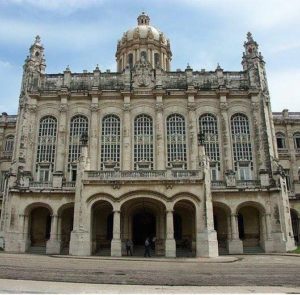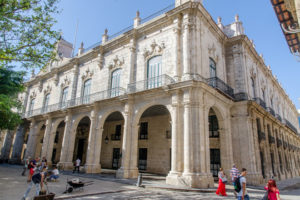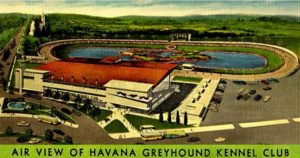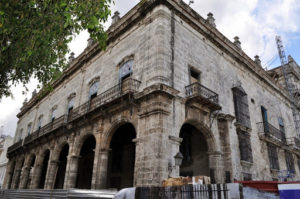 SABIA USTED…?. HISTORIA DE CONSTRUCCIONES DE LA VIEJA HABANA.
SABIA USTED…?. HISTORIA DE CONSTRUCCIONES DE LA VIEJA HABANA.
Los edificios, como las calles, tienen una historia que a veces nos empeñamos en desconocer o que simplemente desconocemos, una historia que muchas veces se hunde en el tiempo. El destino de un edificio puede cambiar de época a época. No es raro que muchos empiecen siendo una cosa y terminen en otra. Veamos algunos casos.
¿Sabrá acaso que la calle 23, en el Vedado, trazada en 1862, se llamó en su momento Paseo de Medina y que el inmueble que ocupa hoy el Instituto Superior de Diseño, en la habanerísima esquina de Belascoaín y Maloja, fue en la República sede del Ministerio de Salubridad y, antes, en la Colonia, un hotel que por albergar a señoras de oficiales españoles muertos en la guerra de Cuba, fue conocido como Casa de las Viudas?
¿Sabía usted que el antiguo Palacio Presidencial, en la calle Refugio número 1, debía acoger al Gobierno Provincial cuando Mariana Seba, primera dama de la República, se antojó del inmueble y consiguió que su esposo, el mayor general Mario García Menocal, lo confiscara y adaptara para sede del Poder Ejecutivo. Ante una decisión presidencial poco o nada podía hacer el Gobernador de La Habana, sino aceptar el medio millón de pesos que ofreció Menocal en compensación y buscar otro sitio para instalarse, mientras el futuro inquilino de la mansión palatina la adaptaba lo mejor posible al gusto de su esposa, pero sin poder evitar que se le viera, en las numerosas ventanas, su origen oficinesco.
Como Estrada Palma y José Miguel, Menocal se instaló en el viejo palacio de la Capitanes Generales, adaptado como despacho oficial y vivienda de los presidentes cubanos. El sitio, sin embargo, no le gustaba, por eso como alternativa se decidió por el palacio de Durañona, en la calle Real —hoy Avenida 51—, como Palacio Presidencial de verano. Pensaba en construir el definitivo en la Quinta de los Molinos, cuando se abrió la posibilidad de adaptar el palacio de la calle Refugio, cuya fachada principal miraba entonces a la calle Trocadero.
El Gobierno Provincial se estableció, en definitiva, en el bellísimo Palacio de los marqueses de Balboa, en la calle Egido, cerca de la Estación Terminal de Ferrocarriles… Pero el general Ernesto Asbert, gobernador de La Habana, que había empezado la construcción del de la calle Refugio, no llegó a disfrutarlo.
Se vio envuelto en la refriega en que perdió la vida el general Armando de la Riva, jefe de la Policía Nacional, y pese a su grado y su cargo fue a dar con sus huesos al Castillo del Príncipe para tirar por la borda su exitosa carrera política que, tarde o temprano, lo hubiera llevado a la presidencia de la República.
Menocal fue el primer mandatario que se instaló en el Palacio de la calle Refugio. Osvaldo Dorticós, ya en la Revolución, fue el último, si bien lo utilizó como lugar de trabajo, nunca como vivienda. La Constitución de 1976 suprimió el cargo de presidente de la República.
El edificio del hoy Ministerio del Interior, en la hoy llamada Plaza de la Revolución, se construyó para Tribunal de Cuentas; es obra del arquitecto Aquiles Capablanca. El edificio donde radican oficinas de las compañías de aviación, en la Rampa habanera, fue, con proyecto del arquitecto Rafael de Cárdenas, un vistoso centro comercial.
El inmueble construido para la Alcaldía de La Habana, también en la Plaza de la Revolución, nunca se utilizó como tal: recién comenzado 1959 pasó a ser sede de la presidencia del Instituto Nacional de Reforma Agraria y, con posterioridad, del Ministerio de las Fuerzas Armadas. La Casa de la FEU, al costado de la Universidad de La Habana, fue la residencia del senador José Manuel Cortina.
El Castillito, en el Vedado, fue la casa club del Balneario Infantil, instalación recreativa y gratuita del municipio, que perdió su área de arena artificial y su salida al mar con la extensión del Malecón hacia el Almendares, y con ellas su razón de ser.
El cine Rodi, en la calle Línea entre A y B, fue en el momento de su apertura (1952) uno de los más lujosos del país; pasó a ser el teatro Mella a comienzos de los años 60.
El frontón de Concordia y Lucena fue el llamado Palacio de los Gritos. Mantuvo, en cuanto a la pelota vasca, una hegemonía absoluta hasta 1921, cuando concluyó la construcción del llamado Nuevo Frontón.
Sería el Palacio de las Luces. Un edificio bellísimo, con muchas comodidades para los aficionados, pero en la prisa por terminarlo se cometió la equivocación de invertir la colocación de las piedras del frontis y del rebote. El deporte del remonte y la pala fracasaba en el Nuevo Frontón ya en 1923. Fracasó el Nuevo Frontón como empresa y, aunque ya quebrado, siguió siendo escenario de algunas temporadas de pelota vasca hasta que cerró definitivamente, tras los daños que en su estructura ocasionó el ciclón de 1926. Con posterioridad al golpe de Estado del 4 de septiembre de 1933, se convirtió en Palacio de los Deportes, hasta que fue adquirido por el movimiento obrero para ubicar la todavía llamada Confederación de Trabajadores de Cuba, lo que se consiguió gracias al aporte económico del senador liberal Alfredo Hornedo.
El cinódromo, en la esquina de la Quinta Avenida y el Gran Bulevar del Country Club —calle 146—, es hoy el centro deportivo Eduardo Saborit. Se construyó a un costo de medio millón de pesos y quedó inaugurado el 12 de junio de 1951. En la finca María, en la curva de Cantarrana, en la carretera de Pinar del Río, poseía perreras para casi 700 animales.
Triste fue el destino del hipódromo Oriental Park, en Marianao. Una instalación que fue en su tiempo orgullo de Cuba y de América, terminó convertida en un depósito de camiones. Se inauguró el 14 de enero de 1915 y no fue la primera instalación de su tipo que hubo en La Habana. Consigue su esplendor entre 1920 y 1928.
 DID YOU KNOW…?. HISTORY OF CONSTRUCTIONS OF THE OLD HAVANA.
DID YOU KNOW…?. HISTORY OF CONSTRUCTIONS OF THE OLD HAVANA.
Buildings, like the streets, have a history that we sometimes insist on ignoring or that we simply do not know, a story that often sinks in time. The fate of a building can change from era to epoch. It is not uncommon for many to start being one thing and end up in another. Let’s look at some cases.
Will you know that 23rd Street, in Vedado, drawn in 1862, was called Paseo de Medina at the time and that the building that the Superior Institute of Design occupies today, in the beautiful corner of Belascoaín and Maloja, was in the Republic headquarters of the Ministry of Health and, before, in Colonia, a hotel that was home to the ladies of Spanish officers killed in the war in Cuba, was known as Casa de las Viudas?
Did you know that the former Presidential Palace , on Refugio street number 1, was to welcome the Provincial Government when Mariana Seba, first lady of the Republic, craved of the property and got her husband, Major General Mario García Menocal, confiscate it and adapt it to the seat of the Executive Power. Faced with a presidential decision, little or nothing could the Governor of Havana do, but accept the half-million pesos offered by Menocal in compensation and find another place to settle, while the future tenant of the palatine mansion adapted it as best as possible to the taste of his wife, but unable to avoid being seen, in the numerous windows, his office origin.
Like Estrada Palma and José Miguel, Menocal settled in the old palace of the General Captains, adapted as the official office and housing of the Cuban presidents. The site, however, did not like it, so as an alternative it was decided by the palace of Durañona, on Calle Real – today Avenida 51 -, as the Summer Presidential Palace. I was thinking of building the definitive in Quinta de Los Molinos, when the possibility of adapting the Refugio street palace was opened, whose main façade then looked at Trocadero street.
The Provincial Government was established, in short, in the beautiful Palace of the Marquises of Balboa, on Egido Street, near the Railroad Terminal Station … But General Ernesto Asbert, governor of Havana, who had begun the construction of Refugio Street, did not enjoy it.
He was involved in the fray in which General Armando de la Riva, head of the National Police, lost his life, and despite his degree and position, he went to the Prince’s Castle with his bones to throw away his successful career policy that, sooner or later, would have taken him to the presidency of the Republic.
Menocal was the first president who settled in the Refugio Street Palace. Osvaldo Dorticós, already in the Revolution, was the last, although he used it as a workplace, never as a home. The 1976 Constitution abolished the office of President of the Republic.
The building of today’s Ministry of Interior , in the now called Revolution Square, was built for the Court of Auditors; It is the work of the architect Aquiles Capablanca. The building where offices of the aviation companies reside, in Havana’s Rampa, was, with the project of the architect Rafael de Cárdenas, a colorful shopping center.
The building built for the Mayor’s Office of Havana, also in the Plaza de la Revolución, was never used as such: just started in 1959 it became the seat of the presidency of the National Institute of Agrarian Reform and, later, of the Ministry of Forces Armed The FEU House, next to the University of Havana, was the residence of Senator José Manuel Cortina.
El Castillito, in Vedado, was the clubhouse of the Children’s Spa, recreational and free installation of the municipality, which lost its artificial sand area and its exit to the sea with the extension of the Malecon towards the Almendares, and with them its raison d’être.
The pediment of Concordia and Lucena was the so-called Palace of Screams. He maintained, as for the Basque ball, an absolute hegemony until 1921, when the construction of the so-called New Frontón was completed.
It would be the Palace of Lights. A beautiful building, with many comforts for fans, but in the rush to finish it the mistake was made to reverse the placement of the stones of the frontis and the rebound. The sport of the ski lift and the shovel failed in the New Frontón already in 1923. The New Frontón failed as a company and, although already broken, it continued being the scene of some Basque ball seasons until it closed definitively, after the damages that in its structure caused the cyclone of 1926. After the coup d’etat of September 4, 1933, it became the Palacio de los Deportes, until it was acquired by the labor movement to locate the still called Confederation of Workers of Cuba, which was achieved thanks to the economic contribution of the liberal senator Alfredo Hornedo.
The Cinodrome , at the corner of Fifth Avenue and the Grand Boulevard of the Country Club —calle 146—, is today the Eduardo Saborit sports center. It was built at a cost of half a million pesos and was inaugurated on June 12, 1951. On the María farm, in the Cantarrana curve, on the Pinar del Río road, it had kennels for almost 700 animals.
Sad was the destination of the Oriental Park racecourse, in Marianao. An installation that was once proud of Cuba and America, ended up converted into a truck depot. It was inaugurated on January 14, 1915, and was not the first installation of its kind in Havana. Get its splendor between 1920 and 1928.
Agencies/ RHC/ Ciro Bianchi/ Extractos/ Excerpts/ Internet Photos/ Arnoldo Varona/ www.TheCubanHistory.com
THE CUBAN HISTORY, HOLLYWOOD.









